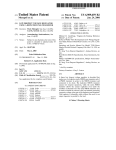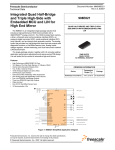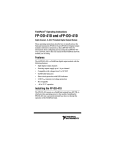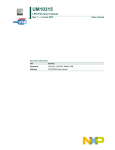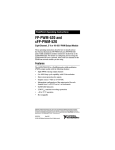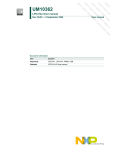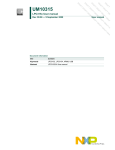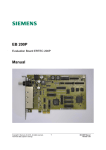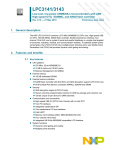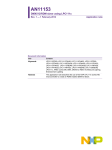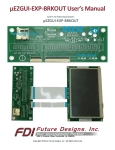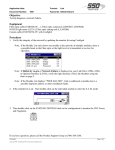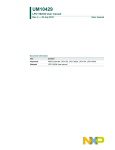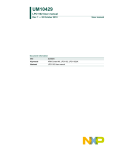Download LPC315x Data Logger/Remote Data Acquisition
Transcript
LPC315x Data Logger/Remote Data Acquisition Board Documentation Circuit board assembly description 1) Main LPC315x Data Logger board – This is the main Data Logger board. 2) RS232 transceiver board – is used for early s/w development, before Linux is running on the platform or before the GSM cellular module begins to use the only UART port on the LPC315x. This board is connected to P15 on the main board to connect the LPC315x UART to a PC serial port over RS-232. 3) uFL to SMA boards – is used to connect antenna (SMA) to the GSM cellular module (uFL) plugged in to the main board at J3. 4) LPC1343 VCOM board – is used to provide a SPI to USB virtual comm. Port for Linux debug. This is needed because there is only one UART port on the LPC315x chip, and it is used for interfacing to the GSM module. The India team will need to develop the s/w for LPC1343 SPI-to-USB Vcomm. This board connects to the main board at P7. 5) RS485 XCVR board – This board contains the RS485 transceiver so the LPC315x UART port can be used to drive the LPC1102 DMX512 Lighting board using standard DMX512 cables. The RS485 XCVR board connects to the main DL board at P15. The GSM cellular module is not useable when the RS485 XCVR board is attached to main board. 6) LPC31xx Audio board – this board is used with LPC315x internal I2S audio codec to support stereo headphone out, stereo line level out, stereo line level in, and Microphone input. This board connects to main board at P8. 7) LPC1102 DMX512 Lighting board – This board is used to demonstrate using the LPC315x as a DMX512 master lighting controller; while the LPC1102 DMX512 Lighting board is the DMX512 client. The LPC1102 DMX512 board has a 3color LED at D300. This board requires a separate power supply (is not powered by main DL board). When power is applied to this board all 3 LEDs are on full brightness. Software to control LPC1102 PWM’s is needed to dim LEDs. Associated Modules which can be used with the LPC315x Data Logger/Data Acquisition Board 1) 900/1800 Mhz ¼ wave antenna – used for GSM cellular module. Also requires uFL-to-SMA board and uFL-to-uFL RF cable to connect antenna to GSM module. 2) WUBR-170GN USB dongle – can add WiFi 802.11 BGN to the Data Logger when installed at J7 and the appropriate drivers have been installed. 3) JN5148-EK010 Evaluation Kit – contains the Jennic 2.4GHz IEEE802.15.4 & JenNet development kit. Main DL board has Jennic JN5148 module with onboard antenna for communication with other Jennic JN5148 modules. The intent is for the Main DL board to be the main controller. LPC315x Data Logger main board 1B Board Power The boards have been shipped to India with jumpers configured for 5V external power (5V power brick supplied). The DL board is also capable of being powered from an external dc power source of 6V – 15V (requires different jumper setting at JP3 and JP4). A 3.6V/3.7V (nominal) Li-Ion battery can be used with either the 5V or 6-15V external power source. External power supply Jumper settings 5V external power supply – JP3 pin 2 jumper to JP4 pin 2; caution do not connect to power supply greater 5.5V in this configuration otherwise there could be damage to components on the board, including the LPC315x. In this configuration the external 5V is supplied directly to the board +5V, which supplies the LPC315x PSU_VBUS. 6V – 15V external power supply – JP3 pin 1 to pin 2 jumper; JP4 pin 1 to pin 2 jumper. In this configuration the external 6-15V is supplied to a step-down power converter which outputs to the board +5V net. Using external power only, no Li-Ion battery When the Data Logger is powered strictly from power mains through the external dc power jack (J4) and no Li-Ion battery will be connected to the board, diode D6 must be installed to get power to the GSM cellular module. Using Li-Ion Battery power When a Li-Ion battery will be used with the Data Logger board (P2 or P2A), ensure that D6 is either not installed or lift D6 pin 1 off the pcb. Battery charger software The LPC315x battery charger software needs to be developed; India team? Power Indicator There is no dedicated power LED indicator on the Data Logger main board. Check 3.3V at P6 pin 2. The 3.3V power is generated by the LPC315x. Data Logger boot The Data Logger boot mode is controlled by the logic level latched at the LPC315x GPIO0, GPIO1 and GPIO2 pins on the rising edge of RSTIN_N pin. The level of GPIO0 is always low by pull-down R93. The level on GPIO1 is determined by R89 and R92; GPIO2 is determined by R83 and R92. The level of GPIO1 is indicated by LED D17 (silkscreen MD1). The level of GPIO2 will be indicated by LED D18 (silkscreen MD2). The LED will be on when GPIOx is high and off when the corresponding GPIOx is low. Boot Mode Table Boot Mode R83 R92 R89 R94 NAND flash Not installed installed Not installed installed SPI Not installed installed installed Not installed DFU installed Not installed Not installed installed SD/MMC installed Not installed installed Not installed SD/MMC Boot The SD/MMC power regulator U4 pin 1 must be high to enable the regulator. By default U4 pin 1 comes up low as it is driven by an external 8-bit register used to provide GPO’s. Board rework required to boot from SD/MMC SD/MMC regulator rework for booting from SD/MMC Lift U4 pin 1 from the pcb to disconnect from U5 pin 5. Short U4 pin 1 to U4 pin 2. List of on-board header style jumpers Header Designator JP1 JP2 JP3 JP4 Description Default Jennic 802.15.4 wireless module U1 nSPI_MEM_WP Open – program flash Closed – SPI Flash write protected GSM cellular module SERVICE mode select Open – non-service mode; normal operation Closed – service mode Route external power at J4 through on-board 5V regulator or bypass regulator. JP3-2 shunted to JP4-2: 5V external power, bypass regulator. JP3-1 shunted to JP3-2; JP4-1 shunted to JP4-2: 6V – 15V open open 5V Ext Power JP3-2 shunted to JP4-2 external power goes to on-board 5v regulator JP5 Nand flash Lock select Open – Nand block lock command enabled, all blocks are protected or locked from program or erase. Closed – Nand block lock disabled; program / erase enabled. closed List of on-board solder jumpers 20B Jumper Description Designator JS1 Jennic 802.15.4 wireless module U1 interrupt to LPC315x GPIO2 Open – disconnect Jennic 802.15.4 wireless interrupt from GPIO2 Closed - connect Jennic 802.15.4 wireless interrupt to GPIO2 JS2 Jennic 802.15.4 wireless module enable flash programming from LPC315x SPI Open – disable Jennic 802.15.4 wireless flash programming from LPC315x SPI Closed – enable Jennic flash programming from LPC315x SPI; Jennic 802.15.4 wireless module must be held in reset while LPC315x programs flash over SPI Default JS3 3.3V connection at GSM Cellular UART trace port P4 Open – 3.3V is disconnected from P4 pin 2; used when FTDI cable is used to connect GSM UART trace to PC USB. Closed – 3.3V is connected to P4 pin 2; use when RS232 XCVR board is used to connect trace port P4 to PC serial port. open JS4 Jennic 802.15.4 wireless module U1 Intelligent Peripheral interface select Open – disable LPC315x SPI_nCS1 from Jennic 802.15.4 wireless module. Closed – enable LPC315x SPI_nCS1 to Jennic 802.15.4 wireless IP select input. D6 installed +PSU_VBUS to +VBAT voltage for GSM module Open – +PSU_VBUS to +VBAT is 3.8V closed JS5 closed open open Jumper Description Designator Closed - +PSU_VBUS to +VBAT is 4.2V JS6 Hardware enable of USB_VBUS_B to +PSU_VBUS Open – s/w must enable USB_VBUS_B to +PSU_VBUS Closed – always enable USB_VBUS_B to power +PSU_VBUS JS7 Disable 300mA load on external power Open – 300mA load applied to external power; use only when board is powered from Li-Ion battery. The 300mA load is used to ensure external voltage source is capable of supplying 300mA of current before s/w switches from battery power to external dc power (i.e. solar panel). Closed – hardware disable of 300mA load; use for tethered external power only (no battery) application. JS8 External power (J4) enabled to power LPC315x +PSU_VBUS Open – External power is s/w controlled to supply power to LPC315x. Used in battery powered application. S/W will check external power under 300mA load prior to switching external power on to +PSU_VBUS. Closed - hardware always enable of external dc power to LPC315x; use for tethered applications with external power only (no battery). JS9 3.3V power to P7 SPI/I2C header for LPC1343 VCOM board Open – no 3.3V supplied to P7 header; LPC1343 VCOM board is powered by the USB Device connector. Closed – 3.3V supplied to P7 JS10 SPI chip select for LPC1343 VCOM at P7 header; close JS12 only one of these solder jumpers. JS13 Open – SPI chip select is not connected to P7 Closed – SPI chip select is connected to P7; close only one switch and be sure the selected SPI chip select is not being used for another device on the SPI bus. JS11 LPC315x 1.8V (+VSUP2) power supplies +VSUP4/8 (external memory bus) power rail Open – LPC315x 1.8V not used to power +VSUP4/8; optional 1.8V power supply U23 used to power +VSUP4/8; JS15 must be closed when JS11 is open. Closed – LPC315x 1.8V (+VSUP2) supplies +VSUP4/8; JS15 must be open when JS11 is closed. JS14 GSM module RING signal connection to LPC315x GPIO1 Open – GSM_RING signal is disconnected from GPIO1 Closed – GSM_RING signal is connected to GPIO1; this does not affect GPIO1 being used for LPC315x boot mode Default open closed closed open All open closed closed Jumper Description Designator select. JS15 On-board 1.8V supply to +VSUP4/8 (external memory bus) Open – on-board 1.8V not used to power +VSUP4/8; LPC315x 1.8V +VSUP2 used to power +VSUP4/8; JS11 must be closed when JS15 is open. Closed – optional on-board 1.8V (U23) supplies +VSUP4/8; JS11 must be open when JS15 is closed. JS16 On-board optional 1.8V power supply input voltage Open – no voltage supplied to U23 input; 1.8V supplied by LPC315x +VSUP2 Closed – voltage supplied to U23; U23 may be used to supply 1.8V JS17 3.3V power to P15 LPC315x UART header Open – no 3.3V supplied to P15 header pin 2; setting when using FTDI cable to interface LPC315x UART to PC USB. Closed – 3.3v supplied to P15 header pin 2; setting when using RS232 XCVR baby board to interface LPC315x UART to PC serial port. JS18 GSM module C104/RXD signal connection to LPC315x UART RXD. Open – GSM RXD signal is disconnected from LPC315x RXD. Use this setting anytime the LPC315x UART is being connected to the RS232 XCVR board or any other cable / device other than the GSM module. Closed – GSM RXD signal is connected to LPC315x RXD; when GSM module is used this must be closed... JS19 Board system reset source select Open – System reset driven by simple RC; C122 must be installed for this mode. Closed – System reset driven by reset supervisor. JS20 3.3V to JTAG connector P14 pin 2; bottom side jumper on PCB. Open – 3.3V disconnected from JTAG connector P14-2. Leave open when the JTAG dongle is self-powered. Closed – 3.3V is connected to JTAG connector P14-2. Close this jumper when the JTAG dongle must be powered from the target. On board connectors & headers 21B Reference Designator J1 J2 J3 Function Ethernet interface SD/MMC slot GSM Cellular module connector; Telit GC864-QUAD_V2 Default open open closed closed closed open Reference Function Designator J4 External DC power; 5V power brick; 6V – 15Vdc Caution: ensure JP3 and JP4 are set correctly for external voltage used otherwise damage could result to the board or LPC315x. J5 Embedded Artists QVGA LCD panel SPI interface for touch screen J6 USB Device interface connector. The LPC315x can only support one USB Device or one USB Host but not both at the same time. The USB Device and Host connectors are multiplexed to the LPC315x. The mux is controlled by s/w. The default after power on is the Device connected to the LPC315x. J7 USB Host interface connector. This connector is multiplexed with J6 for connection to the LPC315x. See J6 function for additional details. J8 ANA2_1 analog sensor input, 3-position screw terminal block. The LPC315x has 3 ADC channels. ADC10B_GPA1 and ADC10B_GPA2 are both connected to an external 4:1 multiplexer chip U15. Which channel of the multiplexer is connected to the LPC315x ADC is set by GPO at U5. Analog inputs must be between 0V – 3.3Vdc. J9 ANA2_0 analog sensor input, 3-position screw terminal block. J10 ANA1_1 analog sensor input, 3-position screw terminal block. J11 ANA1_0 analog sensor input, 3-position screw terminal block. P1 Jennic 802.15.4 wireless module (U1) JTAG connector P2 Li-Ion battery JST 3-pin connector; this is optional connector for battery. P2A Li-Ion battery JST 2-pin connector. P3 Jennic 802.15.4 wireless module serial interface connector. Used for programming the flash on the module. May be connected to either the RS232 XCVR board or FTDI cable to interface to a PC. Programming the module is required to use the Intelligent Peripheral interface for interfacing to LPC315x SPI. P4 GSM cellular module monitor serial interface connector. Used for reprogramming the module. May be connected to either the RS232 XCVR board or FTDI cable to interface to a PC. The GSM module responds to AT commands on serial interface to LPC315x UART. No reprogramming of the GSM module should be needed. P5 Embedded Artists QVGA LCD panel LCD data interface. P6 LPC315x I2C expansion interface; may be used for sensors with I2C. P7 LPC1343 VCOM interface (SPI) P8 LPC315x Audio Codec analog interface to LPC31xx Audio board. P9 LPC315x SPI expansion interface; may be used for sensors with SPI. P10 ANA2_3 analog sensor input, 3-position header. P11 ANA2_2 analog sensor input, 3-position header. P12 ANA1_3 analog sensor input, 3-position header. P13 ANA1_2 analog sensor input, 3-position header. P14 LPC315x JTAG interface 20-pin connector P15 LPC315x UART interface; used to connect RS232 XCVR board for early development debug. Can not be used when GSM module will be used. Board GPIO function The GPIO used on the Data logger board are described in the following table. More GPIO was required than available from the LPC315x alone, so an external 8-bit D-type flip-flop U5 is used for additional GPO’s. GPIO table column descriptions: Column 1 – Function; brief name describing what the GPIO is used for. Column 2 – defines which LPC315x pin name and pin number, or expansion GPO used. Column 3 – defines how the LPC315x GPIO or expansion GPO comes up after power on / reset. Column 4 – voltage rail the GPIO is powered by. The LPC315x GPIO’s powered by VDD_IOA (1.8V) use an external buffer U8 to translate to 3.3V. Column 5 – GPIO function relative to the LPC315x or expansion GPO. The Data logger start up software must program the LPC315x GPIO according to this column. To implement an open-drain output OUT (OD), s/w must program GPIO as output to drive low, but program the same GPIO as input for open-drain state. Column 6 – active level for GPIO GPIO function table Function LPC315x or Default GPIO Function Active External GPO I/O – Vdd_IO In / Out level Expansion - pin PU/PD SPI-to-USB virtual mUART_CTS_N In VDD_I Out low comm chip select /SPI_CS_OUT1 OC – P11 3.3v SPI to USB Vcom I2SRX_WS0 – During VDD_I In low IRQ R9 RST high, OC – then In 3.3v LCD TS SPI CS SPI_CS_OUT0 – Out (high) VDD_I Out low D8 OC – 3.3v Jennic chip SPI CS mUART_CTS_N In VDD_I Out low /SPI_CS_OUT1 OC – P11 (shared with 3.3v VCom Sensor SPI CS mUART_RTS_N Out (high) VDD_I Out low /SPI_CS_OUT2 OC – R11 3.3v LCD_BL_INTENS/ PWM_DATA – In VDD_I Out Pwm/h SHDN D10 OC – igh 3.3v ENET_IRQ mI2STX_BCK0/ Out (clock) VDD_I In low PCM_FSC – T12 OC – 3.3v DevVBUS-2mNAND_RYBN In Vdd_IO Out low PSU_EN 1/MCI_DAT5 – A– C5 1.8V EXT_PWR 2 PSU NAND_NCS_1 – Out (high) Vdd_IO Out low Ena L3 A– Function LPC315x or External GPO Expansion - pin Default I/O – PU/PD GSM_ON/OFF_PU LSE mI2STX_DATA 0/PCM_DA – T13 mNAND_RYBN 3/MCI_DAT7 – D4 mNAND_RYBN 2/MCI_DAT6– D5 GPIO0 – R13 Out (low) GPIO1 – T14 In / PD VDD_I OC – 3.3v In GPIO2 – P12 In VDD_I OC – 3.3v In GPIO3 – D12 In VDD_I OC – 3.3v GPIO4 – D11 In VDD_I OC – 3.3v I2SRX_DATA0 In VDD_I – P9 OC – 3.3v I2SRX_BCK0 – In VDD_I T9 OC – 3.3v NAND_NCS_2 – Out (high) Vdd_IO L4 A– 1.8V NAND_NCS_3 – Out (high) Vdd_IO M2 A– 1.8V mI2STX_CLK0/ Out (clock) VDD_I PCM_DB – T11 OC – In high In low In low In high In Low (OD) Out (OD) Low (OD) In high EXTPWR_400ma_L oad_EN GSM_PWRMON LPC315x Boot_Mod0 / Jennic 802.15.4 wireless module interrupt LPC315x Boot_Mod1 / GSM module RING indicator. LPC315x Boot_Mod2 / GSM module DTR handshake. PSU_STOP LCD Touch sceen Pen_IRQ SD/MMC nCD SD/MMC WP nUSB_Host_Pwr_Fa ult LPC315x nChrg_250mA Stereo Audio LineIn2 detect from In In In / PD GPIO Function Vdd_IO In / Out 1.8V VDD_I OC – 3.3v Vdd_IO A– 1.8V Vdd_IO A– 1.8V VDD_I OC – 3.3v Active level Out high (3.3v) Out high In high In Function LPC31xx Audio board at P8. Stereo Audio LineIn1 detect from LPC31xx Audio board at P8. USB_Host Power ena SD/MMC_PWR_EN Analog Mux sel: EXT_PWR_CHK / nPSU_VBUS monitor Analog port mux select S0 Analog port mux select S1 GSM_RESET USB Mux SEL nDEVICE/HOST Jennic 802.15.4 wireless module reset LPC315x or External GPO Expansion - pin Default I/O – PU/PD mI2STX_WS0/P CM_DCK – R12 Out (clock) VDD_I OC – 3.3v In high GPO EXP – Q0 Out (low) 3.3v Out high GPO EXP – Q1 GPO EXP – Q2 Out (low) Out (low) 3.3v 3.3v Out Out high GPO Exp – Q3 Out (low) 3.3v Out GPO Exp – Q4 Out (low) 3.3v Out GPO Exp – Q5 GPO Exp – Q6 Out (low) Out (low) 3.3v 3.3v Out Out high GPO Exp – Q7 Out (low) 3.3v Out low Key components on main board GPIO Function Vdd_IO In / Out Active level 3.3v 23B IC’s / modules Reference Description Designator U2 Ethernet MAC + PHY; Micrel KSZ8851-16MLL. U1 NXP (Jennic) JN5148-001-M/00T,534 802.15.4 wireless module with onmodule antenna. U4 SD/MMC 3.3V power regulator; Rohm BD33KA5WFP-E2. U5 Expansion GPO; NXP 74LVC273PW. U6 External memory bus 16-bit dual supply transceiver; TI 74AVCA164245GR U7 External dc power step-down 1.2A voltage regulator; used only when JP3, JP4 are strapped for 6v – 15v external power voltage range. Diodes Inc AP5100WG-7. U10 Optional EEPROM for storage of Ethernet MAC address; not installed as default. U11 SDRAM 32M x 16, 1.8V; Micron MT48H32M16LFBF-75:B Reference Description Designator U12 Nand Flash 4Gbit, 2k page, configured 256M x 16, 1.8V; Micron MT29F4G16ABCHC:C. U13 LPC3152 MCU; NXP U15 Dual 4-chan analog mux/demux; used to multiplex two of the LPC315x ADC channels to analog sensors. Sensor voltage range must be between 0v – 3.3Vdc. NXP 74LV4052DB U16 USB high speed multiplexer chip; NXP NX3DV221GM. Allows single LPC315x USB controller to be used either as Device only or Host only. Default is for USB Device. S/W must write to USB Mux SEL nDEVICE/HOST GPO Exp – Q7. U18 External memory bus 8-bit dual supply transceiver; NXP 74AVC8T245PW U20 1-of-2 decoder/demultiplexer; NXP 74LVC1G19GW; used to decode the LPC315x static memory chip select 1 (EBI_nSTCS1) in to two separate address spaces: 1) Ethernet MAC + Phy 0x20020000 – 0x20027FFF (data) or 0x20030xxx (command). 2) Expansion GPO at 0x20028xxx or 0x30038xxx U23 Optional 1.8V power regulator for devices on external memory bus; National Semi LM3670MF-1.8. This regulator is not used as a default. The LPC315x +VSUP2 supplies 1.8V to external memory bus devices. U24 USB Host port VBUS power switch; Micrel MIC2005A-1YM5. U26 Board reset supervisor, 2.63V threshold; Diodes Inc. APX809-26SA. Y1 25Mhz crystal; used for Ethernet MAC + Phy chip. Y2 12Mhz crystal; used for LPC315x main oscillator. Y3 32.768Khz crystal; used for LPC3156 RTC. Switches Reference Description Designator SW1 Jennic 802.15.4 wireless module manual reset; can be used along with SW2 to place the module in flash programming mode. Note: expansion GPO GPO_nRES_ZIG (GPO Exp – Q7) must be driven high before the Jennic module can be programmed or will respond to any serial communication. SW2 Jennic 802.15.4 wireless module SPIMISO_Z; when pressed while SW1 is pressed then released will place the module in programming mode through the serial interface. SW3 When pressed supplies high level to LPC315x PSU_ON. Used to manually turn on LPC315x power supplies when LPC315x is in STOP mode. SW4 Manual Data Logger board system reset. LED’s Reference Description Designator D17 “MD2” silkscreen; Reflects the state of LPC315x GPIO2; at power-on or reset will reflect boot mode bit-2. LED is on when GPIO2 is high; LED is off when GPIO2 is low. D18 “MD1” silkscreen; Reflects the state of LPC315x GPIO1; at power-on or reset will reflect boot mode bit-1. LED is on when GPIO1 is high; LED is off when GPIO1 is low. D1 SD/MMC power indicator D2 GSM Cellular module status LED; See Telit documentation: 1) Telit_GC864-QUAD_V2_Hardware_User_Guide_r3.pdf 2) Telit_AT_Commands_Reference_Guide_r9.pdf LCD 24B The Data Logger supports the Embedded Artists 3.2 inch QVGA color LCD display (EALCD-002) at P5 and J5. LPC1343 VCOM board Board Power 25B The LPC1343 VCOM board is typically powered from the USB Device VBUS connector J202. It is also possible to power the board from the LPC1343 UART connector P201. When the board is powered by P201 the USB Device connector J202 must be disconnected. P7-1 to P7A-1 must be open in both power configurations. See Table for LPC1343 VCOM board operation mode for how power jumpers are configured in each mode. Board / LPC1343 boot 26B To boot the LPC1343 in ISP mode for programming the internal flash add a jumper shunt at JP202. The LPC1343 UART is brought out to P201. The LPC1343 UART port can be connected to a PC through either the RS232 XCVR baby board to PC serial port, or with an FTDI cable to PC USB port. See LPC1343 Operation mode table for jumper connections for each mode and power source. LPC1343 VCOM board operation mode table Operational Power JP201 JP202 Notes Mode Source LPC1343 ISP J202 2-3 closed RS232 XCVR board installed at P201 mode; VBUS 3.3V to program LPC1343 Flash from PC Use RS232 serial port. The RS232 XCVR board XCVR brd is powered from JP201. LPC1343 ISP P201 1-2 closed FTDI cable installed at P201 to mode; FTDI 5V program LPC1343 Flash from PC Use FTDI cable cable virtual comm port. No USB Device installed at J202. LPCxxxx UART J202 2-3 open RS232 XCVR board installed at P201 to USB VCP VBUS 3.3V to interface with any LPCxxxx MCU UART port. RS232 XCVR board is powered from JP201. LPCxxxx SPI / J202 open open P7A used to interface to SPI or I2C I2C to USB VCP VBUS interface of any LPCxxxx MCU. For Data logger SPI-to-VCP debug port jumper P7A pins 2, 3, 4, 5, 6, 9, and 10 to the same pins on main board P7. List of on-board header style jumpers 27B Header Description Designator P7A SPI / I2C interface to LPC315x on main Data logger brd Default Notes open For SPI to USB VCOM connect 2,3,4,5,6,9,and 10 to P7 on main brd. Also select one of three possible SPI chip selects on the DL main board by adding Header Description Designator Default Notes JP201 Power select for P201 open JP202 LPC1343 ISP mode open solder to JS10, JS12 or JS13. When no LCD is used on Data Logger solder JS10. When RS232 XCVR board is installed at P201, jumper JP201_2-3 for 3.3V to XCVR board. When FTDI cable is installed a P201, jumper JP201_1_2 for 5V to power LPC1343 VCOM board from FTDI cable. USB Device must not be installed at J202. Short before power-on or reset to bring up LPC1343 in ISP mode to program internal Flash. On board connectors & headers 28B Reference Description Designator P201 LPC1343 UART interface J202 USB Device conn P202 LPC1343 SWD debug connector Notes Connect either RS232 XCVR baby brd or FTDI cable to program LPC1343 Flash in ISP mode. See LPC1343 VCOM board operation mode table for VCOM board jumper settings. Board typically powered by this connector. USB device must be disconnected when the board is powered by the FTDI cable at P201. RS485 XCVR board Board Power The RS485 XCVR board is powered from the P200 pin 3; the LPC315x UART interface connector. The RS485 XCVR board is connected to the main DL board at P15. SJ17 must be shorted to get 3.3V power to P15. The RS485 transceiver has a separate power pin (VCC, pin 14) for the RS485 differential pair signals, which can be powered at 5V or 3.3V. To power the transceiver VCC from 3.3V install a shunt at JP200_1-2. To power VCC from 5V install a shunt at JP200_2-3 and attach the off-board 5V to TP1. The offboard 5V power supply also needs to be grounded to the RS485 brd at P200 pin 1 or other convenient location. List of on-board header style jumpers Header Description Designator JP200 RS485 transceiver VCC voltage Default Notes Open 3.3V – shunt 1 - 2 5V – shunt 2 – 3, add off-board 5V supply at TP1, and add off board gnd to P200 pin 1. List of on-board solder jumpers Jumper Description Designator JS200 Pull-apart JS201 bias enable Default Notes JS202 120 ohm termination Short JS203 RS485 common tied to GND Short short DMX512 defines a simple resistor divider to bias the RS458 differential pair to ensure a known logic level is received at the master receiver when no clients are on the RS485 bus. 120 ohm termination across the RS485 differential pair when jumper is shorted. The master controller should be located at one far end to the RS485 bus and should have termination on. RS485 is generally tied to gnd at one place on the RS485 bus. This is generally done at the master controller. Multiple connections to gnd are usually ok, but could also create gnd loops causing problems. On board connectors & headers Reference Description Designator P200 LPC315x UART interface Notes P200 is connected to the LPC315x UART interface on the DL main board P15. The transceiver UART interface is powered from P200 pin 2. Ensure the Data logger main Reference Description Designator J200 DMX512 Out J201 RS-485 bus Notes board has JS17 shorted to get 3.3V to P15. The GSM module on the DL main board must not be powered on to use the LPC315x UART port with the RS485 XCVR board. XLR-5F connector used to connect standard DMX512 clients to the DL running a DMX512 lighting master controller application. 3-position screw terminal may also be used to wire up the RS485 bus to client lighting boards for simple wire demonstration. LPC31xx Audio board Board Power The LPC31xx Audio board is powered from the P300 pin 9; the LPC315x audio interface connector. The LPC31xx Audio board is connected to the main DL board at P8. External power supply Jumper settings: There are no power supply jumpers for the LPC31xx audio board. List of on-board header style jumpers: There are no header style or solder style jumpers on the LPC31xx audio board. On board connectors & headers Reference Designator P300 J302 J303 J304 J305 Description Notes LPC315x analog audio signals, 3.3V power, gnd Microphone mono input; Stereo audio line level input1; signal VIN_DETECT high indicates a cable has been plugged in to J303. Stereo audio line level input2; signal TIN_DETECT high indicates a cable has been plugged in to J304. Stereo headphone output; supports 16 – 32 ohm load. S232 XCVR board Board power The RS232 XCVR board is powered from the P15A pin 3; the uart interface connector. The RS232 XCVR board is connected to the main DL board at P15. External power supply Jumper settings: Solder jumper JS17 must be shorted on the main DL board to supply 3.3v power to P15 pin 3. List of on-board header style jumpers: There are no header style or solder style jumpers on the RS232 XCVR board. On board connectors & headers Reference Description Designator P15A LPC315x UART interface P304 DB9 male connector wired as DTE; requires null-modem cable when connecting to a PC serial port. Notes LPC1102 DMX512 lighting board The LPC1102 DMX512 lighting board makes use of three PWM outputs of the LPC1102 to drive the intensity of each color input of the tri-color LED at D300. The LPC1102 analog ADC inputs are connected to a light sensor (Q303) and a temperature sensor U304. The concept is the LPC1102 receives DMX512 lighting commands from the main DL board over RS485. The LPC1102 then programs the PWM according to the DMX512 commands and / or the light and temperature sensors. Board Power The LPC1102 DMX512 board is powered from a 5V power brick attached to connector J306. Power may also be supplied by a 5V bench supply connected using TP2 (5V power) and TP3 (GND). When power is applied to an unprogrammed LPC1102 the PWM outputs come up as inputs with pull-up, causing each LED to be lit with maximum intensity. The LED at maximum intensity is quite bright; you may want to cover the LED while working with an unprogrammed LPC1102 DMX512 board. External power supply Jumper settings: There are no power supply jumpers on the LPC1102 DMX512 board. Board / LPC1102 boot The LPC1102 has no dedicated ISP entry pin. Therefore, user code is required to invoke ISP functionality. Unprogrammed parts automatically boot into ISP mode. The LPC1102 UART is brought out to P302. The LPC1102 UART port can be connected to a PC through either the RS232 XCVR baby board to PC serial port, or with an FTDI cable to PC USB port. Caution - when using an FTDI cable to program the LPC1102 it is necessary to disconnect the FTDI cable pin 3 from P302. This is because the FTDI cable will output 5V on pin 3. See the LPC1102 User manual for details of booting the LPC1102. List of on-board header style jumpers 39B Header Description Designator JP300 RS-485 120 ohm terminations enable. Default Notes JP301 Open RS485 transceiver VCC voltage open Open – termination is disabled. Shorted – termination is on across the RS485 + to – signal. Add termination when only the LPC1102 DMX512 board is the last board connected in the RS485 daisy chain, or if it’s the only board on the RS485 bus to a DMX512 master. 3.3V – shunt 1 - 2 5V – shunt 2 – 3 List of on-board solder jumpers Jumper Description Designator JS300 LPC1102 P0_9 to UART connector CTS JS301 LPC1102 P0_8 to UART connector RTS JS302 LPC1102 UART RXD connect to RS458 transceiver receive output. JS303 RS485 common tied to GND Default Notes open Leave open Open Leave open short Open – when using LPC1102 ISP. Short – to use RS485 transceiver for DMX512 interface. Short RS485 is generally tied to gnd at one place on the RS485 bus. This is generally done at the master controller. Multiple connections to gnd are usually ok, but could also create gnd loops causing problems. On board connectors & headers Reference Description Notes Designator P301 LPC1102 serial wire debug P302 LPC1102 UART Used for LPC1102 ISP to program internal flash. port connector P303 DMX512 In 5-pin male XLR connector DMX512 input to the LPC1102 DMX512 board. J300 RS485 3This connector can be used to connect a small RS485 position terminal network between a main DL board (DMX512 master block. controller) and a LPC1102 DMX512 board (DMX512 slave). J301 DMX512 Out 5-pin female XLR-5F connector used as the output connector when daisy chain to another DMX512 client (slave) board. When this connector is used the termination should be disabled by leaving JP300 open. J306 5V dc power input. TP2 +5V test point Use to connect +5V bench top power supply to the LPC1102 Lighting board. TP3 GND test point Use to connect bench top power supply to the LPC1102 Lighting board Key components on main board Reference Designator U300 U302 U303 U304 D300 SW300 Description MAX13432EETD+, Maxim. RS485 transceiver SA57000-33D , NXP. 3.3v voltage regulator. LPC1102 MCU; NXP LM335M/NOPB, National Semi. Two-terminal zener Precision Temperature Sensor. The LM135 has a breakdown voltage directly proportional to absolute temperature at +10 mV/°K. CLV6A-FKB-CK1P1G1BB7R3R3; Cree. high performance tricolor (red, green, blue) SMT LED. LPC1102 MCU reset




















